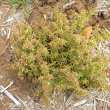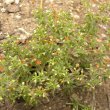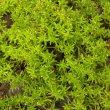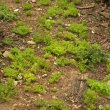Crassula expansa subsp. expansa
| Botanical Name | Crassula expansa subsp. expansa |
|||||||||||
| Family | Crassulaceae - The crassula family. |
|||||||||||
| Pronunciation | KRASS-oo-la ek-SPAN-sa subsp. ek-SPAN-sa |
|||||||||||
| Common Name(s) | ||||||||||||
| Plant Group |
|
|||||||||||
| Plant Size |
|
|||||||||||
| Position |
|
|||||||||||
| General Information |
|
|||||||||||
| Specific Information | A dwarf perennial succulent. Leaves appear on jointed stems that can reach up to 40 cm in length. Leaves vary from pale green to reddish, some specimens having a distinct red marking on the upper surface of the leaf. The leaves are succulent, narrow and boat shaped (0.6-2cm long and 0.2-0.4cm wide). This is a resilient little plant, able to tolerate full sun and dry conditions, but with only a moderate tolerance to drought. It grows very well in light and partial shade, quickly spreading outwards to form rounded clumps. As with many ground hugging crassulas, it deteriorates soon after flowering, but this period does not last for much more than a month or two, after which it quickly re-establishes itself. Useful for miniature gardens. |
|||||||||||
| Ad Break | ||||||||||||
| Flowers | ||||||||||||
| Description | tiny solitary star-shaped flowers on the ends of the branchlets. |
|||||||||||
| Season |
|
|||||||||||
| Colour |
|
|||||||||||
| Growth Rate |
|
|||||||||||
| Plant Uses |
|
|||||||||||
| Distribution and Habitat | in all provinces of South Africa, and north throughout tropical and sub-topical Africa, in sandy soil and often near the ocean |
|||||||||||
| Planting Suggestions | This little crassula thrives best if planted where it can have some shade, at least during the hottest part of the day. By positioning it under other plants or below a tree it is then also protected it from light frost. Good drainage is essential or the plant will rot, so clay is out but most soils will do. Thrives in shade with occasional watering and is remarkably useful around the garden to soften edges and fill open spots. The rooting system is very shallow and the clumps fall apart easily.to plant, water the location lightly the evening before. Check the soil and if it appears very impoverished, mix some organic matter into the soil before watering. Loosen the soil of the chosen spot and make a shallow depression about the same circumference as the plant clump. Keep the clump contained.Place the clump in the depression and just snuggle the roots into the loose soil below, using only the fingertips. Tuck some soil under the outer edges and sprinkle some of the loose soil over the plant - just enough to help anchor the roots. Press any bits that have separated from the clump into the loose soil around the mother plant. Water lightly to settle the soil without runoff. A thin layer of mulch can be scattered around the plant to conserve water, but too much mulch prevents it from spreading readily. |
|||||||||||
| Medicinal Uses | No data found. |
|||||||||||
| Ad Break | ||||||||||||








Discuss this plant
Share knowledge, ask a question or give an experience.